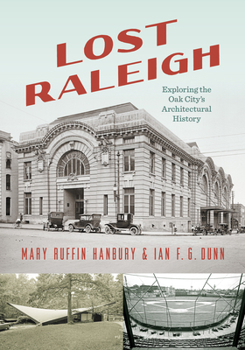Lost Raleigh: Exploring the Oak City's Architectural History
Landmarks with great historical, architectural, and cultural value are often demolished in the name of progress, leaving little but memories behind. In the growing city of Raleigh, many important buildings have been razed, but even when no longer present, these landmarks hold histories that can help us understand not only what Raleigh used to look like but what kind of place Raleigh used to be.
Mary Ruffin Hanbury and Ian F. G. Dunn, building on the work of the late Karl Larson, have gathered photographs and stories of Raleigh landmarks from the late eighteenth century to the late twentieth century, including private homes, public and educational buildings, parks, malls, churches, and businesses. Among these noteworthy places are the home of controversial newspaper editor Josephus Daniels; the nineteenth-century municipal building Metropolitan Hall; and the famous Eduardo Catalano house. Full of photos and fascinating stories, Lost Raleigh is a comprehensive look at the city's cultural and architectural past and a plea to protect and preserve the landmarks that make our cities unique, connecting us to our shared history.





